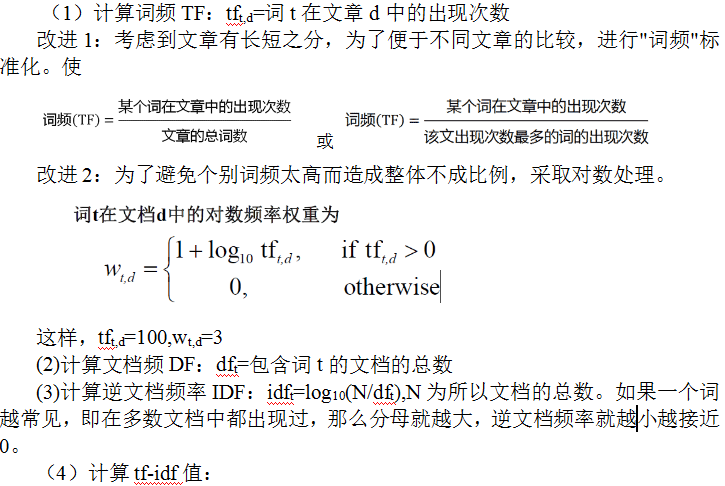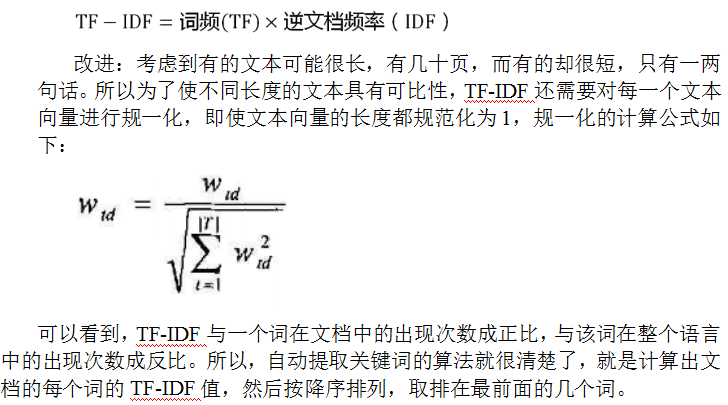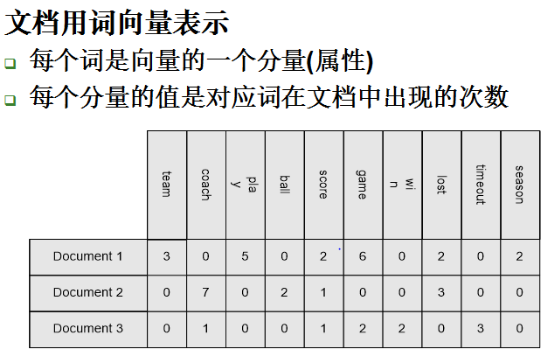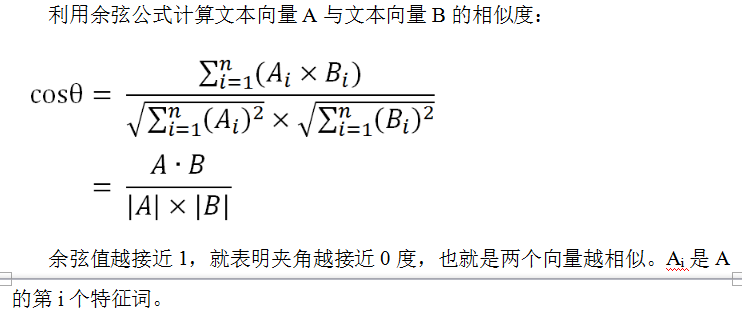建立文本数据数学描写叙述的过程分为三个步骤:文本预处理、建立向量空间模型和优化文本向量。
文本预处理主要採用分词、停用词过滤等技术将原始的文本字符串转化为词条串或者特点的符号串。文本预处理之后,每个文本的词条串被进一步转换为一个文本向量,向量的每一维相应一个词条,其值反映的是这个词条与这个文本之间的类似度。类似度有非常多不同的计算方法。所以优化文本向量就是採用最为合适的计算方法来规范化文本向量,使其能更好地应用于文本分类和文本聚类等方面。
TFIDF算法
TF-IDF使得一个单词能尽量与文本在语义上相关。TF-IDF算法的实现步骤:
经过试验发现,用TFIDF/max(TFIDF)的方法效果是最好的。详细代码例如以下:
import java.io.File;
import java.util.HashMap;
import java.util.Iterator;
import java.util.Map;
import java.util.Set;
/**
* 经过试验发现,用TFIDF/max(TFIDF)的方法效果是最好的
* @author Angela
*/
public class TFIDF {
private Map<String,Integer> TF;//文本词频集
private Map<String,Double> IDF;//特征-逆文档频率集
/**
* 构造方法,初始化TF和IDF
*/
public TFIDF(Map<String,Integer> TF,Map<String,Double> IDF){
this.TF=TF;
this.IDF=IDF;
}
/**
* 计算文本特征集的tf-idf权值
* @return filePath文件的特征-TFIDF集
*/
public Map<String,Double> getTFIDF(){
Map<String,Double> tfidf=new HashMap<String,Double>();
for(Map.Entry<String,Integer> me: TF.entrySet()){
String f=me.getKey();
double weight=me.getValue()*IDF.get(f);
tfidf.put(f, weight);
}
return tfidf;
}
/**
* 计算文本特征集的对数tf-idf权值
* @return filePath文件的特征-TFIDF集
*/
public Map<String,Double> getLogTFIDF(){
Map<String,Double> tfidf=new HashMap<String,Double>();
for(Map.Entry<String,Integer> me: TF.entrySet()){
String f=me.getKey();
double tf=1+Math.log(me.getValue());
double weight=tf*IDF.get(f);
tfidf.put(f, weight);
}
return tfidf;
}
/**
* 进行规一化,每个特征除以这篇文本TFIDF值之和,构成新的TFIDF集
* @return filePath文件的特征-标准化TFIDF集
*/
public Map<String,Double> getNormalTFIDF(){
Map<String,Double> tfidf=new HashMap<String,Double>();
Map<String,Double> weight=getTFIDF();
double sum=MathUtil.calSum(weight);//计算TFIDF总和
for(Map.Entry<String, Double> me: weight.entrySet()){
String f=me.getKey();
double w=me.getValue()/sum;
tfidf.put(f, w);
}
return MapUtil.descend(tfidf);
}
/**
* 进行标准化,每个特征除以这篇文本中最大的TFIDF值,构成新的TFIDF集
* @return filePath文件的特征-标准化TFIDF集
*/
public Map<String,Double> getStandardTFIDF(){
Map<String,Double> tfidf=new HashMap<String,Double>();
Map<String,Double> weight=getTFIDF();
Map<String,Double> temp=MapUtil.descend(weight);
Set<Map.Entry<String, Double>> set = temp.entrySet();
Iterator<Map.Entry<String,Double>> it = set.iterator();
double max=0;
if(it.hasNext()){
max=it.next().getValue();
}
for(Map.Entry<String, Double> me: weight.entrySet()){
String f=me.getKey();
double w=me.getValue()/max;
tfidf.put(f, w);
}
return MapUtil.descend(tfidf);
}
/**
* 保存文本的TFIDF结果
* @param tf 文本的TF集
* @param idf IDF集
* @param savePath 保存路径
*/
public static void saveTFIDF(Map<String,Integer> tf,
Map<String,Double> idf,String savePath){
TFIDF tfidf=new TFIDF(tf,idf);
Map<String,Double> weight=tfidf.getStandardTFIDF();
Writer.saveMap(weight, savePath);
}
/**
* 保存TFIDF结果
* @param filePath 文本集的TF集路径
* @param idfPath IDF路径
* @param tarPath 保存路径
*/
public static void saveTFIDF(String TFPath,String IDFPath,String tarPath){
File tar=new File(tarPath);
if(!tar.exists()) tar.mkdir();
Map<String,Double> idf=Reader.toDoubleMap(IDFPath);//IDF
File file=new File(TFPath);
File[] labels=file.listFiles();//类别
for(File label: labels){
String labelpath=tarPath+File.separator+label.getName();
File labelPath=new File(labelpath);
if(!labelPath.exists()) labelPath.mkdir();
File[] texts=label.listFiles();//文本
for(File text: texts){
String savePath=labelpath+File.separator+text.getName();
Map<String,Integer> tf=Reader.toIntMap(text.getAbsolutePath());
saveTFIDF(tf,idf,savePath);
System.out.println("Saved "+savePath);
}
}
}
public static void main(String args[]){
String TFPath="data\\r8trainTF";
String IDFPath="data\\r8trainIDF.txt";
String tarPath="data\\r8trainTFIDF3";
saveTFIDF(TFPath,IDFPath,tarPath);
}
}
向量空间模型VSM
余弦类似度
文本与文本之间的类似度不能简单地用欧式距离来计算。更合理的计算方式是余弦类似度。
以下就是涉及这两个知识点的工具类。
MathUtil存放通用的计算公式方法
import java.util.Map;
/**
*
* @author Angela
*/
public class MathUtil {
/**
* 计算Map的键值之和
* @param map
* @return
*/
public static double calSum(Map<String,Double> map){
double sum=0;
for(Map.Entry<String,Double> me: map.entrySet()){
sum+=me.getValue();
}
return sum;
}
/**
* 计算两篇文本的类似度
* @param text1 文本1
* @param text2 文本2
* @return text1和text2的余弦类似度。值越大越类似
*/
public static double calSim(Map<String,Double> text1,
Map<String,Double> text2){
double sim=0;//类似度
double sum=0;//同样特征的权重相乘之和
double len1=0;//文本1的长度
double len2=0;//文本2的长度
for(Map.Entry<String,Double> me: text1.entrySet()){
String f=me.getKey();
double value=me.getValue();
if(text2.containsKey(f)){
sum+=value*text2.get(f);
}
len1+=value*value;
}
for(Map.Entry<String,Double> me: text2.entrySet()){
double value=me.getValue();
len2+=value*value;
}
sim=sum/(Math.sqrt(len1)*Math.sqrt(len2));
return sim;
}
}
GetData获取DF、TFIDF即VSM、类别成员clusterMember、类别列表LabelList及由TFIDF构造的其他数据
import java.io.File;
import java.util.ArrayList;
import java.util.HashMap;
import java.util.HashSet;
import java.util.List;
import java.util.Map;
import java.util.Set;
/**
*
* @author Angela
*/
public class GetData {
/**
* 依据TFIDF得到相应的DF集合
* 假设你的TFIDF集仅仅是原始的一部分,就用这种方法来获取相应的DF集
* @param tfidf TFIDF集合
* @return
*/
public static Map<String,Integer> getDF(Map<String,Map<String,Double>> tfidf){
Map<String,Integer> map=new HashMap<String,Integer>();
for(Map.Entry<String,Map<String,Double>> me: tfidf.entrySet()){
Map<String,Double> text=me.getValue();
for(Map.Entry<String,Double> t: text.entrySet()){
String feature=t.getKey();
if(map.containsKey(feature)){
map.put(feature,map.get(feature)+1);
}else{
map.put(feature, 1);
}
}
}
return map;
}
/**
* 读取文本集,返回Map<类别+文件名称,Map<特征,权重>>
* 当你进行特征选择后,得到特征子集,能够用这种方法
* 从文本集中构建新的VSM
* @param filePath TFIDF存放路径
* @param featureSet 特征集
* @return
*/
public static Map<String,Map<String,Double>> getTFIDF(String filePath,
Set<String> featureSet){
Map<String,Map<String,Double>> map=new HashMap<String,Map<String,Double>>();
File path=new File(filePath);
File[] files=path.listFiles();//类别
for(File file: files){
String label=file.getName();
File[] texts=file.listFiles();//文本
for(File text: texts){
Map<String,Double> tfidf=Reader.toDoubleMap(text.getAbsolutePath());
Map<String,Double> temp=new HashMap<String,Double>();
for(Map.Entry<String,Double> me: tfidf.entrySet()){
String feature=me.getKey();
if(featureSet.contains(feature)){
temp.put(feature,me.getValue());
}
}
map.put(label+File.separator+text.getName(), temp);
}
}
return map;
}
/**
* 依据特征集构建新的VSM,返回Map<类别+文件名称,Map<特征,权重>>
* 当你进行特征选择后,得到特征子集,能够用这种方法
* 从原始的VSM中构建新的VSM
* @param tfidf 原始的VSM
* @param featureSet 特征集
* @return
*/
public static Map<String,Map<String,Double>> getTFIDF(
Map<String,Map<String,Double>> tfidf,Set<String> featureSet){
Map<String,Map<String,Double>> map=new HashMap<String,Map<String,Double>>();
for(Map.Entry<String,Map<String,Double>> me: tfidf.entrySet()){
Map<String,Double> text=me.getValue();
Map<String,Double> temp=new HashMap<String,Double>();
for(Map.Entry<String,Double> t: text.entrySet()){
String feature=t.getKey();
if(featureSet.contains(feature)){
temp.put(feature,t.getValue());
}
}
map.put(me.getKey(), temp);
}
return map;
}
/**
* 依据TFIDF文本集和特征集构建
* Map<特征,Map<文本路径名,特征在该文本中的TFIDF值>>
* @param tfidf TFIDF文本集
* @param featureSet 特征集
* @return
*/
public static Map<String,Map<String,Double>> getTermIndex(
Map<String,Map<String,Double>> tfidf,Set<String> featureSet){
Map<String,Map<String,Double>> termIndex=
new HashMap<String,Map<String,Double>>();
for(String f: featureSet){//特征
//包括有特征f的全部文本及特征f在该文本中的权重
Map<String,Double> feature=new HashMap<String,Double>();
for(Map.Entry<String,Map<String,Double>> me: tfidf.entrySet()){
Map<String,Double> text=me.getValue();//文本
if(text.containsKey(f)){//假设文本包括特征f
//将文本的路径和特征f的值赋给feature
feature.put(me.getKey(), text.get(f));
}
}
//将特征及feature赋给termIndex
termIndex.put(f,feature);
}
return termIndex;
}
/**
* 依据文本特征集和特征集构建Map<特征,Set<文本路径名>>
* @param dataSet Map<文本,Set<特征>>
* @param featureSet 特征集
* @return
*/
public static Map<String,Set<String>> getFeatureIndex(
Map<String,Set<String>> dataSet,Set<String> featureSet){
Map<String,Set<String>> featureIndex=
new HashMap<String,Set<String>>();
for(String f: featureSet){//特征
Set<String> textSet=new HashSet<String>();
for(Map.Entry<String,Set<String>> me: dataSet.entrySet()){
String textPath=me.getKey();//文本路径
Set<String> feature=me.getValue();//文本的特征集
//假设文本包括特征f
if(feature.contains(f)){
textSet.add(textPath);
}
}
//将特征及文本集赋给termText
featureIndex.put(f,textSet);
}
return featureIndex;
}
/**
* 文本集的类别成员
* @param filePath
* @return
*/
public static Map<Integer,List<String>> getClusterMember(String filePath){
Map<Integer,List<String>> clusterMember=new HashMap<Integer,List<String>>();
File file=new File(filePath);
File[] labels=file.listFiles();
int labelNum=labels.length;
for(int i=0;i<labelNum;i++){
File[] texts=labels[i].listFiles();
String label=labels[i].getName();
List<String> member=new ArrayList<String>();
for(File text: texts){
member.add(label+File.separator+text.getName());
}
clusterMember.put(i, member);
}
return clusterMember;
}
/**
* 类别集
* @param filePath
* @return
*/
public static List<String> getLabelList(String filePath){
List<String> labelList=new ArrayList<String>();
File files=new File(filePath);
File[] file=files.listFiles();
for(File f: file){
labelList.add(f.getName());
}
return labelList;
}
/**
* 依据TFIDF集构造类别集
* @param TFIDF
* @return
*/
public static List<String> getLabelList(Map<String,Map<String,Double>> TFIDF){
Set<String> labels=new HashSet<String>();
for(Map.Entry<String,Map<String,Double>> me: TFIDF.entrySet()){
String path=me.getKey();
String label=path.substring(0,path.lastIndexOf(File.separator));
labels.add(label);
}
List<String> labelList=new ArrayList<String>(labels);
return labelList;
}
}由于文本数据量一般非常大,并且VSM具有高维稀疏的特点。所以一般须要进行特征选择。来降低特征的数量。
下一节,我将介绍几种特征选择方法。

























 2万+
2万+

 被折叠的 条评论
为什么被折叠?
被折叠的 条评论
为什么被折叠?








